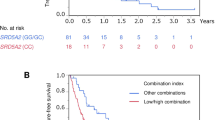Abstract
Background
Hormone ablation therapy is the standard therapy for prostate cancer; however, there are large individual differences in the duration of response to the therapy. We investigated, in this retrospective multicenter study, the association between genetic polymorphic variations in steroidogenesis-related genes and the risk of progression to castration-resistant prostate cancer (CRPC) in Japanese patients after androgen deprivation therapy.
Methods
Two hundred and fourteen Japanese patients with prostate cancer who were receiving androgen deprivation therapy were enrolled in this study. We investigated 22 single-nucleotide polymorphisms (SNPs) from 8 genes related to steroidogenesis. The SNPs were assayed by polymerase chain reaction (PCR)-based methods. The different genotypes in this cohort were analyzed according to a case–control status of progression to CRPC at the median duration of hormonal therapy. A logistic regression method with adjustments for patients’ characteristics was applied for the analysis.After applying the logistic regression method, we performed Cox regression analysis, following Kaplan–Meier and log-rank analyses.
Results
In the logistic regression analysis four genetic polymorphisms, rs743572, rs6162, rs6163, and rs1004467, in the CYP17A1 gene were significantly associated with a risk of progression to CRPC (p < 0.05). Cox regression analysis for these SNPs showed an association of risk of progression to CRPC with the rs743572 genotype (p = 0.02, odds ratio [OR] 0.43, 95 % confidence interval [CI] 0.22–0.85).
Conclusion
The genetic backgrounds for CYP17A1 genes could influence the progression of prostate cancer to CRPC after androgen deprivation therapy.



Similar content being viewed by others
References
Quinn M, Babb P (2002) Patterns and trends in prostate cancer incidence, survival, prevalence and mortality. Part II: individual countries. BJU Int 90(2):174–184
Edwards J, Krishna NS, Grigor KM et al (2003) Androgen receptor gene amplification and protein expression in hormone refractory prostate cancer. Br J Cancer 89(3):552–556
Fujimoto N, Miyamoto H, Mizokami A et al (2007) Prostate cancer cells increase androgen sensitivity by increase in nuclear androgen receptor and androgen receptor coactivators; a possible mechanism of hormone-resistance of prostate cancer cells. Cancer Invest 25(1):32–37
Arnold JT, Le H, McFann KK et al (2005) Comparative effects of DHEA vs. testosterone, dihydrotestosterone, and estradiol on proliferation and gene expression in human LNCaP prostate cancer cells. Am J Physiol Endocrinol Metab, 288(3):E573–584
Shah S, Small E (2010) Emerging biological observations in prostate cancer. Expert Rev Anticancer Ther 10(1):89–101
D’Amico F, Biancolella M, Margiotti K et al (2007) Genomic biomarkers, androgen pathway and prostate cancer. Pharmacogenomics 8(6):645–661
Ross RW, Oh WK, **e W et al (2008) Inherited variation in the androgen pathway is associated with the efficacy of androgen-deprivation therapy in men with prostate cancer. J Clin Oncol 26(6):842–847
Singh AS, Chau CH, Price DK et al (2005) Mechanisms of disease: polymorphisms of androgen regulatory genes in the development of prostate cancer. Nat Clin Pract Urol 2(2):101–107
Torkko KC, van Bokhoven A, Mai P et al (2008) VDR and SRD5A2 polymorphisms combine to increase risk for prostate cancer in both non-Hispanic White and Hispanic White men. Clin Cancer Res 14(10):3223–3229
Maeda O, Usami M (2005) Summary of General rules for clinical and pathological studies on prostate cancer (3rd edition). Nihon Rinsho 63(2):201–206
Akaza H (2006) Trends in primary androgen depletion therapy for patients with localized and locally advanced prostate cancer: Japanese perspective. Cancer Sci 4:243–247
De Coster R, Wouters W, Bruynseels J (1996) P450-dependent enzymes as targets for prostate cancer therapy. J Steroid Biochem Mol Biol, 56(1–6 Spec No):133–143
Attard G, Reid AH, A’Hern R et al (2009) Selective inhibition of CYP17 with abiraterone acetate is highly active in the treatment of castration-resistant prostate cancer. J Clin Oncol 27(23):3742–3748
de Bono JS, Logothetis CJ, Molina A et al (2011) Abiraterone and increased survival in metastatic prostate cancer. New Engl J Med 364(21):1995–2005
Reid AH, Attard G, Danila DC et al (2010) Significant and sustained antitumor activity in post-docetaxel, castration-resistant prostate cancer with the CYP17 inhibitor abiraterone acetate. J Clin Oncol 28(9):1489–1495
Antognelli C, Mearini L, Talesa VN et al (2005) Association of CYP17, GSTP1, and PON1 polymorphisms with the risk of prostate cancer. Prostate 63(3):240–251
Mononen N, Seppala EH, Duggal P et al (2006) Profiling genetic variation along the androgen biosynthesis and metabolism pathways implicates several single nucleotide polymorphisms and their combinations as prostate cancer risk factors. Cancer Res 66(2):743–747
Habuchi T, Liqing Z, Suzuki T et al (2000) Increased risk of prostate cancer and benign prostatic hyperplasia associated with a CYP17 gene polymorphism with a gene dosage effect. Cancer Res 60(20):5710–5713
Kakinuma H, Tsuchiya N, Habuchi T et al (2004) Serum sex steroid hormone levels and polymorphisms of CYP17 and SRD5A2: implication for prostate cancer risk. Prostate Cancer Prostatic Dis 7(4):333–337
Peduzzi P, Concato J, Kemper E et al (1996) A simulation study of the number of events per variable in logistic regression analysis. J Clin Epidemiol 49(12):1373–1379
Benjamini Y. Hochberg Y. (1995) Controlling the false discovery rate: a practical and powerful approach to multiple testing. J R Statist Soc ser B, 57(1): 298–300
Attard G, Reid AH, Yap TA et al (2008) Phase I clinical trial of a selective inhibitor of CYP17, abiraterone acetate, confirms that castration-resistant prostate cancer commonly remains hormone driven. J Clin Oncol, 26(28):4563–4571
Acknowledgments
We thank the following investigators who participated in this study: Kensaku Nishimura (Osaka Rosai Hospital), Tsuneo Hara (Ikeda Municipal Hospital), Go Tanigawa (Osaka General Medical Center), and Toshiaki Yoshioka (Sumitomo Hospital).
Conflict of interest
The authors declare no conflict of interest.
Author information
Authors and Affiliations
Corresponding author
About this article
Cite this article
Yamada, T., Nakayama, M., Shimizu, T. et al. Genetic polymorphisms of CYP17A1 in steroidogenesis pathway are associated with risk of progression to castration-resistant prostate cancer in Japanese men receiving androgen deprivation therapy. Int J Clin Oncol 18, 711–717 (2013). https://doi.org/10.1007/s10147-012-0430-8
Received:
Accepted:
Published:
Issue Date:
DOI: https://doi.org/10.1007/s10147-012-0430-8




